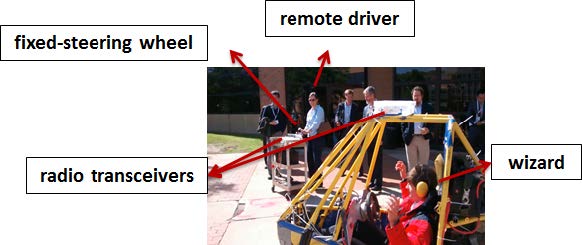Human-Autonomy Interaction
Annual PlanQuantifying the Benefits of Haptic Shared Control for Remotely Controlled and Semi- Automated Ground Vehicles
Project Team
Government
Paramsothy Jayakumar, Keith Briggs, U.S. Army GVSC
Faculty
Sile O’Modhrain, University of Michigan
Industry
John Walsh, Ford Motor Co.Image
Student
Akshay Bhardwaj, Paul Boehm, University of Michigan
Amirhossein Ghasemi (post-doc), University of Michigan
Project Summary
Project began 2018.

The problem of remote UGV (unmanned ground vehicle) control is closely related to driver engagement and interaction with Driver Assistance systems, which is of high interest in the auto industry. UGVs span a wide spectrum in their mode of operation from teleoperated to fully autonomous, with semi-autonomous in the middle. Teleoperation describes the mode in which the remote human operator controls all actions of the UGV and the UGV has no intelligence to sense and react to its environment. In the semi-autonomous mode, the control authority is shared between the human operator and an autonomy module. In the fully autonomous mode the autonomy module is responsible for controlling all actions of the UGV. The research challenges in the center of the spectrum (semiautonomy) include how to divide the control authority between the human operator and autonomy for best performance, both with and without communication delays. How much improvement in performance semi-autonomy can offer is also an open research question.
The objective of this project is to realize a means for a human driver and autonomy module to share control over a UGV. The challenge is to combine the strengths of human control (perception, situational awareness, experience, judgement) and automatic control (accuracy, speed, inexhaustibility) to achieve system performance that exceeds the performance possible when either agent acts alone. To combine strengths, we aim to share control in such a way that both the human driver and autonomy module will be informed of the actions of the other and can take over as necessary. When aware of the autonomy’s actions, the driver can best take advantage of the assist and adapt to the dynamic challenges present when driving in unstructured and unmapped environments. We are particularly interested in addressing dynamic driving tasks that necessitate real-time negotiation of control authority. We propose to quantify the advantages of control sharing and negotiation relative to alternative approaches in which the actions of the autonomy module are shielded from the driver.
Our approach to control sharing “haptic shared control” is being tested on an experimental platform in the form of a mini baja vehicle and a ground control station, both equipped with motorized steering wheels. The baja vehicle and ground station steering wheels are linked using a position-position teleoperator controller so that a human driver at the ground station can both control vehicle steering and feel the actions of an autonomy module onboard, whose role is played by an onboard human driver in a Wizard-of-Oz paradigm. This baja vehicle and associated apparatus has become a rich platform for testing the benefits of haptic shared control relative to alternative approaches.
Publications:
- Ghasemi A.H., Johns M., Garber B., Boehm P., Jayakumar P., Ju W. and Gillespie R.B., “Role Negotiation in a Haptic Shared Control Framework”, Automotive User Interfaces and Interactive Vehicular Applications Conference (AutomotiveUI), 2016.
- Boehm P., Ghasemi A.H., O’Modhrain S., Jayakumar P. and Gillespie R.B., “Architectures for Shared Control of Vehicle Steering ” IFAC - Human and Machine Symposium, 2016.
- Ghasemi A.H., Boehm P., Gillespie R.B. and Jayakumar, P., “Haptic Shared Control in Automated Driving”, American Control Conference, 2016.

